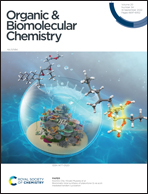Tuning the selectivity of amino acid recognition with dynamic covalent bond constrained fluorophores in aqueous media†
Abstract
The recognition and discrimination of amino acids are generating continuous interest due to their importance. Herein we developed a series of dynamic covalent reaction constrained aldehyde-derived fluorescent probes for the binding of amino acids with tunable selectivity. Diverse emission behaviors were obtained via pH triggered movement of ring-chain tautomerization equilibrium of aldehyde probes. By taking advantage of the distinct pKa and reactivity of aldehyde probes and amino acids, unique fluorescence signaling patterns were generated, and the selectivity for amino acid recognition was further modulated. The selective recognition of Cys/Hcy was attained at pH 7.4 as a result of thiazolidine formation. The manipulation of the reactivity at pH 10 enabled the realization of high selectivity for His and Cys, respectively. Moreover, pH and redox stimuli-responsive dynamic covalent networks were constructed for the regulation of amino acid recognition. The strategies and results described should be appealing in many aspects, including dynamic assemblies, molecular sensing, biological labeling, and smart materials.



 Please wait while we load your content...
Please wait while we load your content...